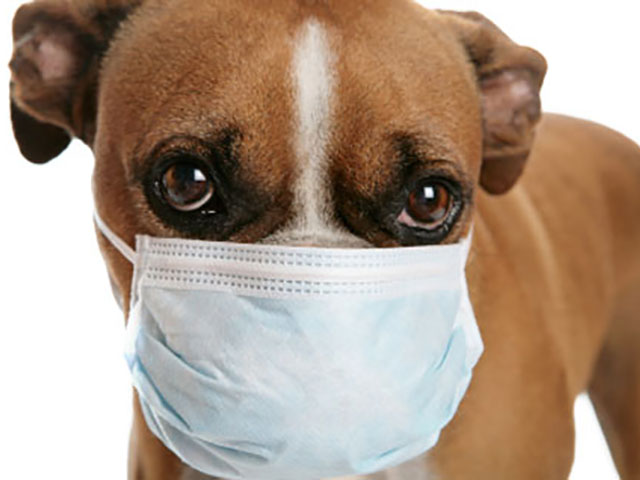Another summer is here and dog owners are being bombarded with news about a new flu virus infecting dogs everywhere in the United States. This has created much confusion, and a good amount of misinformation. So, let’s deal with the confusion by reviewing the facts.
There are two strains of the Canine Influenza Virus (CIV), the older and better known H3N8, and the newer and more contagious H3N2. It is the latter that is believed to have transferred from birds to dogs in Asia and brought to this country through infected dogs, resulting in an outbreak in Chicago in 2015. Since then, the virus has spread, affecting dogs in almost every single state. In recent months, since May 2017, we have been witnessing a second outbreak. A special characteristic of this new H3N2 virus is that it is highly contagious; every single dog that is exposed will become infected. Another characteristic of H3N2 is that the severity of the infection is unpredictable. Twenty percent of infected dogs will show no symptoms, and most dogs will show cold-like symptoms, while others will have a rapidly progressing disease that could lead to hemorrhagic pneumonia and, without timely treatment, possibly death. The CIV is special in that infected dogs will be contagious to other dogs for a long time, almost a full month, regardless of if they are showing symptoms or not. There are reports of the CIV crossing species and affecting cats.
So, what are the symptoms? The dog will have general symptoms of respiratory disease; very similar to the “Kennel Cough” disease (Bordetella/Parainfluenza complex for which dogs are vaccinated annually). The symptoms of CIV infection include coughing, sneezing, lethargy, fever, lack of appetite and mucous discharging from the nose. If the dog’s condition quickly gets worse or is coughing blood, there is a possibility that he/she might be infected with the CIV and not with the better known Kennel Cough.
Dogs can be infected through the air (sneeze or cough from infected dog), by licking or sniffing other dogs, or through contact with infected objects such as food bowls and cloth.
The Canine Flu virus infection has been seen in locations shared by multiple dogs such as kennels, grooming places, dog parks, dog shows/sport competitions, dog training classes, highway resting stops, and common green areas in apartment complexes. The CIV can be easily diagnosed through a blood or nasal mucosa test. Treatment is supportive, requiring antibiotic therapy. For dogs with severe disease, hospitalization for more aggressive therapy might be required.
The best way to avoid the CIV infection is through prevention. If your dog lifestyle puts him/her at risk of contracting the disease, a vaccine will provide protection from the two variations of the Canine Flu Virus (H3N8 and H3N2). Two boosters are required. The vaccine will minimize the symptoms, and will prevent shedding of the virus. Also, it is recommended to avoid big dog crowds if possible, and to wash your hands when touching multiple dogs. Lastly, if your dog is coughing, do not take him/her to areas where there are other dogs that might get infected. Early diagnosis and treatment of the CIV increases the potential of a good outcome. If your dog is showing respiratory symptoms, a comprehensive exam by your veterinarian, and proper diagnostics will identify the cause and will allow early treatment.










 Deering Estate
Deering Estate
 Massage Envy South Miami
Massage Envy South Miami
 Calla Blow Dry
Calla Blow Dry
 My Derma Clinic
My Derma Clinic
 Sushi Maki
Sushi Maki
 Sports Grill
Sports Grill
 The Healthy Kitchen
The Healthy Kitchen
 Golden Rule Seafood
Golden Rule Seafood
 Malanga Cuban Café
Malanga Cuban Café

 Kathleen Ballard
Kathleen Ballard
 Panter, Panter & Sampedro
Panter, Panter & Sampedro
 Vintage Liquors
Vintage Liquors
 The Dog from Ipanema
The Dog from Ipanema
 Rubinstein Family Chiropractic
Rubinstein Family Chiropractic
 Your Pet’s Best
Your Pet’s Best
 Indigo Republic
Indigo Republic




 ATR Luxury Homes
ATR Luxury Homes


 2112 Design Studio
2112 Design Studio
 Hamilton Fox & Company
Hamilton Fox & Company
 Creative Design Services
Creative Design Services
 Best Pest Professionals
Best Pest Professionals
 HD Tree Services
HD Tree Services
 Trinity Air Conditioning Company
Trinity Air Conditioning Company
 Cisca Construction & Development
Cisca Construction & Development
 Mosquito Joe
Mosquito Joe
 Cutler Bay Solar Solutions
Cutler Bay Solar Solutions


 Miami Royal Ballet & Dance
Miami Royal Ballet & Dance
 Christopher Columbus
Christopher Columbus
 Pineview Preschools
Pineview Preschools
 Westminster
Westminster
 Carrollton
Carrollton
 Lil’ Jungle
Lil’ Jungle
 Frost Science Museum
Frost Science Museum
 Palmer Trinity School
Palmer Trinity School
 South Florida Music
South Florida Music
 Pinecrest Orthodontics
Pinecrest Orthodontics
 Dr. Bob Pediatric Dentist
Dr. Bob Pediatric Dentist
 d.pediatrics
d.pediatrics
 South Miami Women’s Health
South Miami Women’s Health

 The Spot Barbershop
The Spot Barbershop
 My Derma Clinic
My Derma Clinic




 Miami Dance Project
Miami Dance Project

 Rubinstein Family Chiropractic
Rubinstein Family Chiropractic
 Indigo Republic
Indigo Republic

 Safes Universe
Safes Universe
 Vintage Liquors
Vintage Liquors
 Evenings Delight
Evenings Delight





 Atchana’s Homegrown Thai
Atchana’s Homegrown Thai
 Baptist Health South Florida
Baptist Health South Florida

 Laser Eye Center of Miami
Laser Eye Center of Miami
 Visiting Angels
Visiting Angels
 OpusCare of South Florida
OpusCare of South Florida

 Your Pet’s Best
Your Pet’s Best





 HD Tree Services
HD Tree Services
 Hamilton Fox & Company
Hamilton Fox & Company


 Creative Design Services
Creative Design Services